Rules of Tablut
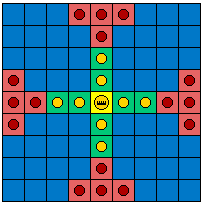 Karl van Linne, also known as Linnaeus, is today chiefly known for the system he devised for the classification of living organisms. In 1732 he journeyed through Lapland, taking copious notes on everything he saw, including an interesting indiginous game called Tablut.
Karl van Linne, also known as Linnaeus, is today chiefly known for the system he devised for the classification of living organisms. In 1732 he journeyed through Lapland, taking copious notes on everything he saw, including an interesting indiginous game called Tablut.
The game Linnaeus observed was probably played on embroidered reindeer skin. The playing field is layed out in 9 x 9 squares. The central square is known as the konakis, or throne. The sides are unequal - eight blond Swedes and their king against 12 dark Muscovites. The pieces occupy the positions shown in the figure, with the king occupying the central throne.
I have found several differing rules of play for this game. The following, for various subjective reasons, I consider to be the most accurate and playable:
- All pieces move any number of vacant squares orthagonally (the rook's move in chess). Each player moves one of his pieces in turn. The Swedes move first.
- Only the king may occupy the konakis and the corner squares. Other pieces may pass through the konakis when it is unoccupied, but may not stop there.
- Pieces are captured indirectly, using what is known as a "custodian" capture. When a player traps an opponent's piece between two of his own (orthagonally, but not diagonally), he lifts his opponent's piece from the board. Note that it is possible to capture two, or even three pieces in a single move with this method. However, a player may safely move a piece onto a square between two enemy pieces.
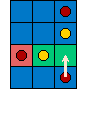
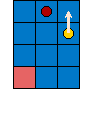
- A piece may also be captured by trapping it between an enemy piece and a corner square (orthagonally, but not diagonally).
- The king may not participate in captures.
- The king is captured if he is surrounded on all four orthagonal sides by enemy pieces, or on three sides by enemy pieces and on the fourth by the konakis or the edge of the board, or on two sides by enemy pieces, on the third by the edge of the board, and on the fourth by a corner square. If the king is captured, the Muscovites win.
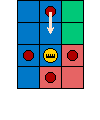
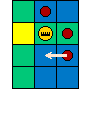
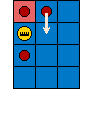
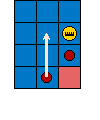
- If the king reaches any of the four corner squares, the Swedes win. If the king gains an open path to a corner during the Swede's move, the player must warn his opponent by saying Raichi! If the king has two clear paths to corners, the player says Tuichi!, which is equivalent to "checkmate", as there is no way the king can be blocked from two routes in a single move.
On the web board, click on a piece, then click on the square to which you want to move. Assuming the move is legal, the move will be completed. The status line at the bottom of the browser indicates the side that has the move. If scroll bars appear on the web board page, try maximizing your browser window and getting rid of the directory buttons from the options menu. The web-board requires Netscape Navigator 3.0 or better, with JavaScript enabled.
Play Tablut!







 Karl van Linne, also known as Linnaeus, is today chiefly known for the system he devised for the classification of living organisms. In 1732 he journeyed through Lapland, taking copious notes on everything he saw, including an interesting indiginous game called Tablut.
Karl van Linne, also known as Linnaeus, is today chiefly known for the system he devised for the classification of living organisms. In 1732 he journeyed through Lapland, taking copious notes on everything he saw, including an interesting indiginous game called Tablut.




